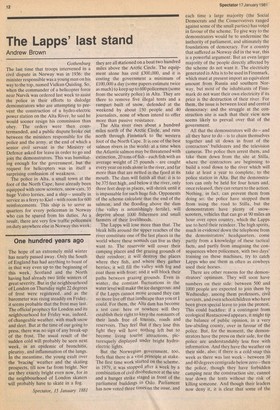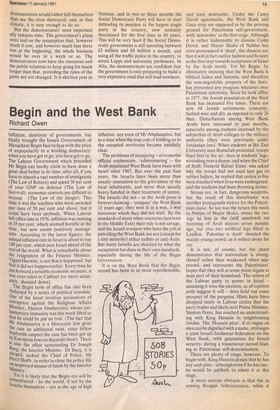The Lapps' last stand
Andrew Brown
Gothenburg The last time that troops intervened in a civil dispute in Norway was in 1936: the minister responsible was a young man on his way to the top, named Vidkun Quisling. So, when the commander of a helicopter force near Narvik was ordered last week to assist the police in their efforts to dislodge demonstrators who are attempting to prevent the construction of a hydro-electric power station on the Alta River, he said he would sooner resign his commission than obey. The orders were then countermanded, and a public dispute broke out between the ministers responsible for the police and the army, at the end of which a senior civil servant in the Ministry of Defence asked for leave in order to go and join the demonstrators. This was humiliating enough for the government, but the request for helicopters was in itself a surprising confession of weakness.
The police in Alta, a small town at the foot of the North Cape, have already been equipped with snow scooters, snow-cats, 35 huge Volvo lorries, and a ship — usually in service as a ferry to Kiel — with room for 600 reinforcements. This ship is to serve as quarters for every policeman in Norway who can be spared from his duties. As a result, there are very few traffic policemen on duty anywhere else in Norway this week; they are all stationed on a boat two hundred miles above the Arctic Circle. The equipment alone has cost £300,000, and it is costing the government a minimum of £100,000 a day (some papers estimate twice as much) to keep up to 600 policemen (some from the security police) in Alta. They are there to remove five illegal tents and a rampart built of snow, defended at the weekend by about 150 people and 40 journalists, none of whom intend to offer more than passive resistance.
The Alta river rises about a hundred miles north of the Arctic Circle, and runs north through Finntnark to the western foot of the North Cape. It is one of the best salmon rivers in the world: at a time when the Atlantic salmon may be threatened with extinction, 20 tons of fish — each fish with an average weight of 25 pounds — are caught every year on rods alone in the river, and far more than that are netted in the fjord at its mouth. The darn will finish all that: it is to be 375 feet high, and below it the river, only three feet deep in places, will shrink until it is impassable for such huge fish. Opponents of the scheme calculate that the end of the salmon, and the flooding above the dam (the valley is astonishingly fertile), will deprive about 1000 fishermen and small farmers of their livelihoods.
The Lapps will lose more than that. The bleak hills around the upper reaches of the river constitute one of the last places in the world where these nomads can live as they want to. The reservoir will cover their camping places and the grazing grounds of their reindeer; it will destroy the places where they fish, and where they gather berries; it will fill the valley with fog and coat them with frost; and it will block their paths between grazing grounds. Even in winter, the constant fluctuations in the water level will make the ice dangerous: and if the Lapps cannot move around they can no More live off that landscape than you or I could. For them, the Alta dam has become a test case: here or nowhere will they establish their right to keep the remnants of their lands free of tourists, roads and reservoirs. They feel that if they lose this fight they will have nothing left but to become living tourist attractions, picturesquely displayed under bright hydroelectric lights.
But the Norwegian government, too, feels that there is a vital principle at stake.
The first time work started on the scheme,
in 1979, it was stopped after a week by a combination of civil disobedience at the site
and a hunger strike staged in front of the parliament buildings in Oslo. Parliament has now voted three times on the issue, and each time a large majority (the Social Democrat's and the Conservatives ranged against some of the small parties) has voted in favour of the scheme. To give way to the demonstrators would be to undermine the authority of parliament, and ultimately the foundations of democracy. For a country that suffered as Norway did in the war, this is a powerful argument. But an even larger majority of the people directly affected by the scheme do not want it. The electricity generated in Alta is to be used in Finnmark, which must at present import an equivalent amount from Russia and southern Norway, but most of the inhabitants of Finnmark do not want their own electricity if its price is the destruction of their river. For them, the issue is between local and central democracy: and the struggle at the construction site is such that their view now seems likely to prevail over that of the government.
All that the demonstrators will do — and all they have to do — is to chain themselves together and sit down in front of the contractors' bulldozers and the television cameras. The police then arrest them, and take them down from the site at Stilla, where the contractors are beginning to build a road down to the river which will take at least a year to complete, to the police station in Alta. But the demonstrators can only be held for four hours and, once released, they can return to the action. Nothing, in fact, can prevent them from doing so: the police have stopped them from using the road to Stilla, but the demonstrators have plenty of snowscooters, vehicles that can go at 90 miles an hour over open country, which the Lapps use to herd their reindeer. The high spirits, much in evidence down the telephone from the demonstrators' headquarters, come partly from a knowledge of these tactical facts, and partly from imagining the consequences when policemen, with two days' training on these machines, try to catch Lapps who use them as often as cowboys used their horses.
There are other reasons for the demonstrators' optimism. They will soon have numbers on their side: between 500 and 1000 people are expected to join them by Wednesday, among them professors, civil servants, and even schoolchildren who have been given special leave to join the protest. This could backfire: if a contingent from ecological Rentacrowd appears, it might tip the balance of public opinion, in a very law-abiding county, over in favour of the police. But, for the moment, the demonstrators have the press on their side, for the police are understandably less free with information. And they have the weather on their side, also; if there is a cold snap this week as there was last week — between 30 and 40 degrees centigrade below zero — then the police, though they have forbidden camping near the construction site, cannot tear down the tents without the risk of killing someone. And though their leaders now deny it, it is clear that some of the demonstrators would rather kill themselves than see the river destroyed; and, in that climate, it is easy enough to do so. But the demonstrators' most important ally remains time. The government's plans were laid on the assumption that, however much it cost, and however much fuss there was at the beginning, the whole business would be over in a week or so. The demonstrators now have the resources and the public relations to keep going for much longer than that, providing the rules of the game are not changed. It is election year in Norway, and in two or three months the Social Democratic Party will have to start defending its position as the largest single party in the country, now seriously threatened for the first time in 60 years. This will be very hard if the Social Democratic government is still spending between 13 million and £4 million a month, and using all the traffic police in the country, to arrest Lapps and university professors. In Alta, the demonstrators are confident that the government is only preparing to build a very expensive road that will lead nowhere.



































 Previous page
Previous page